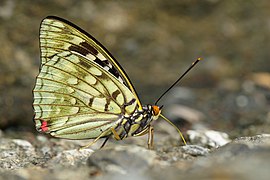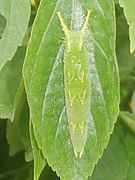Sasakia charonda
| Sasakia charonda | ||||||||||||
|---|---|---|---|---|---|---|---|---|---|---|---|---|

Sasakia charonda , male |
||||||||||||
| Systematics | ||||||||||||
|
||||||||||||
| Scientific name | ||||||||||||
| Sasakia charonda | ||||||||||||
| ( Hewitson , 1863) |
Sasakia charonda is occurring in Asia Butterfly ( butterfly ) from the family of Nymphalidae (Nymphalidae). The name of the genus Sasakia was chosen in honor of Chujiro Sasaki , a professor of zoology and entomology at Imperial University Tokyo . Sasakia charonda is the national butterfly of Japan . There he is calledオ オ ム ラ サ キ ( Oomurasaki = large purple butterfly). In English usage, the type is called Japanese Emperor .
features
butterfly
The wingspan of the moth is 90 to 120 millimeters. The species is characterized by a clear sexual dimorphism . In the males the upper side of the wing is strongly iridescent blue to violet blue , in the larger females however without Schiller. Investigations of the microstructure of the wing scales of male moths using scanning electron microscopy and optical microscopy showed that the multiple interference of light between the cuticle layers of the scales produces the iridescence. It is also assumed that the structures of the scales have an impact on aerodynamically easy flight and the drainage of wet wings. Both sexes have in common the black-brown basic color of the upper sides of the wings and the white spot pattern on them. The males also show a red spot on the anal corner of the hind wings. The color of the underside of the wing is essentially light gray-green, with the drawing elements of the upper sides shining through faintly. The proboscis is yellow.
Caterpillar, pupa
The caterpillars are green in color and have yellowish, hump-like tubercles that run obliquely backwards. Her two headphones and one end of the body tapering into a double point are striking. Their overall appearance resembles a slug .
The doll has an elongated shape that ends in two points at the lower end. It is colored green and is attached to branches, trunks or leaves as a falling doll with a webbing anchorage.
Distribution, subspecies and habitat
The species is found in Japan , Taiwan , Korea, and eastern China . Four subspecies are currently classified in the various occurrence areas . Sasakia charonda primarily inhabits dense deciduous forests.
Way of life
The moths fly in one generation from June to August. They like to be in the treetops. Occasionally they suckle on injured trees, droppings or damp places in the earth in order to absorb tree sap or other liquids and minerals. The females lay between 50 and 200 eggs, which they lay in several small groups on the leaves of the food plant. The caterpillars hatch after five days and prefer to feed on the leaves of the Chinese hackberry tree ( Celtis sinensis ). The species overwinters in the pupal stage. A mortality rate of 30% was found.
Hazard and protection
Sasakia charonda was often found in deciduous forests in Japan in the past. Due to the rapid economic growth, the increase in population density, the deforestation of forest areas, the use of land for the construction of roads, buildings and industrial plants, the stock decreased significantly. The Japanese Ministry of the Environment and Nature Conservation therefore classified Sasakia charonda in 2000 as “ Near Threatened ” . As a first measure, the removal of animals of this type from nature was prohibited.
Individual evidence
- ↑ F. Moore: LEPIDOPTERA Indica, Vol III. , Lovell Reeve & Co., Ltd., London, 1896-1899, p 39
- ↑ Niels P. Kristensen: Lepidoptera, moths and butterflies. In: Maximilian Fischer (Ed.): Handbook of Zoology. 1st edition. Volume 4 - Arthropoda: Insecta, Teilband 35, de Gruyter, Berlin, New York 1998, ISBN 3-110-15704-7 , p. 289
- ↑ Jiřina Matějková-Plšková, Satoshi Shiojiri and Makoto Shiojiri: Fine structures of wing scales in Sasakia charonda butterflies as photonic crystals , Materials Transactions, vol. 236, 2009, pp. 88–93 ( doi : 10.1111 / j.1365-2818.2009.03233.x )
- ↑ Distribution and subspecies
- ↑ a b c Takato Kobayashi & Masahiko Kitahara: Effect of vegetation types on oviposition preference of the giant purple emperor, Sasakia charonda , Journal of Forest Research, 2005, Vol. 10, No. 3, pp. 167-172
Web links
- animaldiversity - Animal Diversity Web




